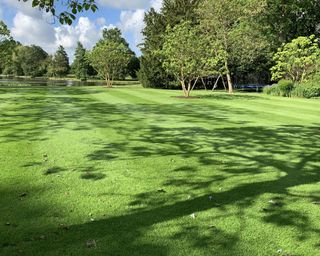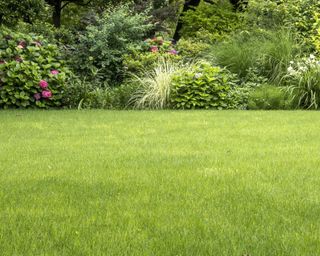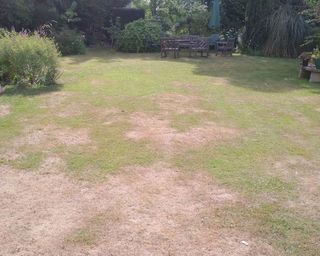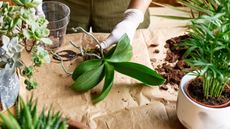How to make your grass greener: expert tips to get your lawn looking lush again
Discover how to make your grass greener with our expert tips and your lawn will soon be back to its best


If you're wondering how to make your grass greener again you're probably on the tail end of a summer heatwave, drought or hosepipe ban. If so, your lawn is probably looking parched and brown instead of the velvety green stripes you had in mind.
Water is essential for keeping grass green but in the event there's a shortage there are still things you can do to give your lawn a helping hand. Without regular watering, grass growth will be slow and it's best to leave it be.
If you do want to keep your grass looking neat make sure you mow it on your lawn mower's highest possible setting so you don't cause any further damage. It's best to avoid carrying out law maintenance care like aeration or scarification too until it rains or any hosepipe ban gets lifted.
Here's the latest expert advice on what to do as part of your lawn care routine this summer and get your grass back to looking good.

Look after your lawn and it will soon be looking green and healthy again
Expert advice on how to make your grass greener

We asked David Hedges Gower, chairman of the Lawn Association, for his top tips on how to make your grass grow greener again, particularly in summer heatwaves. David established his successful lawn care company in 2004 and has since taken the topic of lawn care to a new level, creating unprecedented access to modern lawn care expertise.
- Water: The easiest way to green up your lawn is, of course, to water, from a sustainable water source wherever possible. It's best to water late evening as grass grows most at night during hot weather.
- Feed: Does a lawn need feeding during summer heatwaves? This is a frequently asked question when it comes to how to make your grass greener and the answer is yes. But always use an organic feed. It will be safe and start working as soon as it rains.
- Mow: Unless your lawn is parched and brown you can keep mowing but make sure you do it properly. A blunt blade on your lawn mower will add to any grass stress. Soon you could even be mastering how to mow stripes on a lawn.
- Raise the blades: Grass forms a protective canopy over soil and the shorter you mow, the more likely it is the soil will become baked and compacted. Raise the mower height as high as it can go to let grass absorb more food and water.
- Investigate: You need to find out what prolonged dry weather and drought has done to your lawn and figure out how to correct it and rebalance things.
- Prune: Scarifying your lawn after a drought will inevitably lead to a better, greener lawn. Removing any dead, decomposing material will allow new re-growth to flourish, so find out how to scarify a lawn to give your grass the boost it needs.
- Breathe: Soils are key to lawns and need air for their root systems, so learn how to aerate a lawn. It will allow better use of water, fertilizers and inevitably lead to greener grass.
- Nurture: One key aspect in getting greener grass is to work with nature. Heavy rain requires more aeration to take water away from the surface. Dry spells affects soil too by reducing air space, so rebalance with correct aeration techniques.
- Adapt: Grasses have been slowly adapting for thousands of years and we are finding some grass species are starting to establish better during consistent dry spells. Let your lawn grow what wants to grow in it.
- Relax: The best thing to do now is forget about how brown your lawn may have become. The majority will bounce back as soon as rain comes, as they do every year. Other species will fill in gaps, plants are stronger and more native grasses will proliferate.

One of David Hedges Gower's beautifully green lawns
Should I water my grass to keep it looking green?
All to often we realise too late in the day that our grass is looking withered when the weather gauge has already hit high and the midday sun is blazing. Instead plan ahead by checking the weather forecast and watering at the right time of day.
'Avoid watering your lawn during the hottest period of the day,' advises Chris McIlroy of The Grass People. 'Most of the water will simply evaporate. Watering it during cooler parts of the day, like the morning or night time, will be much more beneficial.'
'Give your lawn a good soaking once a week, rather than little and often,' says lawn care consultant and Pro Lawn Care MD Richard Salmon, 'as this method could lead to evaporation before getting to the soil where it's needed.'

Velvety soft green grass takes some effort but is so worth it
Is there anything else I can do to make my grass greener?
The most important thing you can do to keep your lawn happy is to reduce the amount of stress it's put under. It's also well worth considering how to grow grass in hot dry weather if you want to keep it looking good at the height of summer.
'A drought can be stressful enough for grass, so walking or playing on it should be discouraged too,' says Peter Chaloner, MD at lawn mower experts Cobra Garden. Make sure you remove any objects such as garden furniture, barbecues or paddling pools that may be covering it as well.
'Covering grass for too long can cause it to burn. We also recommend keeping pets off the grass as much as possible, as their wee can also scorch and burn grass.'
If you want to pet proof your lawn, find out how to grow grass with dogs to keep your turf in tip-top condition.

This patchy brown lawn can be made good again with the right care
What's the quickest way to get my lawn green again?
The reason your lawn is brown is usually due to a lack of water exacerbated by excessive heat. 'The solution is to water the lawn to rehydrate the soil,' says Richard Salmon. 'Natural rainfall will green it up better than any other form of water as it doesn’t contain any chlorine.'
Failing that, you can irrigate a lawn from the mains water by using a garden hose and garden sprinkler or a watering can, but this is still not as good as natural rain water, and it might not be legal, if a hosepipe ban is in force. There are plenty of simple ways to collect rainwater, such as with a water butt or rain barrel, so that you can use it on your lawn.
It's also a good idea to apply a liquid or granular feed as part of your recovery plan for how to make your grass greener. 'Applying a feed will help the lawn recover after a period of drought,' says Richard. 'The use of nitrogen and other vital nutrients will encourage the grass to produce green leaf growth and root growth to aid recovery. If it's short of available nutrients it won't recover as quickly.
'I'm confident that lawns will continue to thrive and adapt to the changing climate,' continues Richard. 'Now more than ever we need to appreciate the benefits our lawn brings to our lives, such as producing oxygen to help us breathe, removing Co2 from the atmosphere, capturing dust and pollen, and cooling the air around us.'
If the worst happens and your lawn doesn't recover, you can always find out how to plant grass seed and how to repair lawn patches so you can carry out a quick repair job.


Lifestyle journalist Sarah Wilson has been writing about gardens since 2015. She's written for Gardeningetc.com, Livingetc, Homes & Gardens, Easy Gardens and Modern Gardens magazines. Having studied introductory garden and landscape design, she is currently putting the skills learned to good use in her own space where the dream is establishing a cutting garden.
-
 Do you need to chit potatoes? Find out what the experts say
Do you need to chit potatoes? Find out what the experts sayGrow Your Own Learn how to chit potatoes before planting them in the ground and you’ll be on your way to getting an earlier and bigger harvest
By Drew Swainston Published
-
 What causes orchid root rot and how do you solve it?
What causes orchid root rot and how do you solve it?Plants Discover the causes of orchid root rot so you can prevent this common problem from killing your plant
By Sarah Forsyth Published
